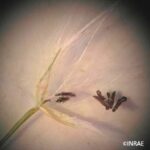
Miscanthus: A New Crop in France
Author :
Maryse Brancourt-Hulmel
Miscanthus: A New Crop in France
Botanical Origins
The name “miscanthus” is derived from two Greek words referring to the distinct features of its flower. “Mischos” refers to the pedicel, a small stalk at the base of the flower in the panicle, while “anthos” denotes the flower itself.
Miscanthus belongs to the Poaceae family and the Andropogoneae tribe, which includes crops like maize, sorghum, and sugar cane. It covers a wide area in East and Southeast Asia, with natural hybrids forming in regions where its parent species, M. sacchariflorus and M. sinensis, overlap. Miscanthus x giganteus is the hybrid cultivar cultivated in France, originating from a spontaneous cross between M. sacchariflorus and M. sinensis.
Miscanthus Cultivation in France
Miscanthus is a perennial grass that can be grown for many years, typically 20 to 25 years for M. x giganteus. The crop is sterile and poses no risk of seed dispersal, thanks to its lack of fertility. Grown from rhizomes, the plant is propagated vegetatively. It requires little input, especially nitrogen fertilizer, and is resistant to pests and diseases, making it a low-maintenance crop.
The plants are harvested annually, typically in late winter when they have dried and contain 80-85% dry matter. The stalks are often chopped and stored for use in various applications, such as biofuels, horticultural mulch, or animal bedding.
Uses and Market Applications
Miscanthus was first used in horticulture in France, with its first agricultural plantation in Alsace in 1993. The demand for miscanthus increased in the 2000s, driven by its potential in biofuel production. Today, it has found additional markets in mulching materials for horticulture, animal bedding, and even construction materials, including composites used by the automotive industry.
Environmental Benefits
Miscanthus offers significant ecological benefits. It stores carbon in the soil and can improve water quality by absorbing nitrates. Additionally, it helps prevent soil erosion, particularly in flood-prone areas. These ecosystem services have been recognized, with miscanthus now considered an ecological interest surface under agricultural policies.
Challenges and Sociopolitical Perceptions
Despite its advantages, the adoption of miscanthus faces challenges. Farmers must adjust to new cultivation techniques, including specialized machinery for planting and harvesting. The financial commitment required for establishment, particularly the cost of rhizomes, is also a concern. However, some government agencies cover these costs for projects aimed at ecosystem services.
Public concern has been raised about its potential invasiveness, but as the plants used for agriculture are sterile, this risk is minimal. Nonetheless, the cultural association with bamboo has led to fears that miscanthus may spread uncontrollably.
Future Prospects
The miscanthus industry is expanding, with increasing demand for ecosystem services and potential new markets. However, there is still much to learn about the crop’s genetics and genetic diversity. As more research is conducted, new varieties will likely be developed to meet the varied needs of farmers, industry, and the environment.
